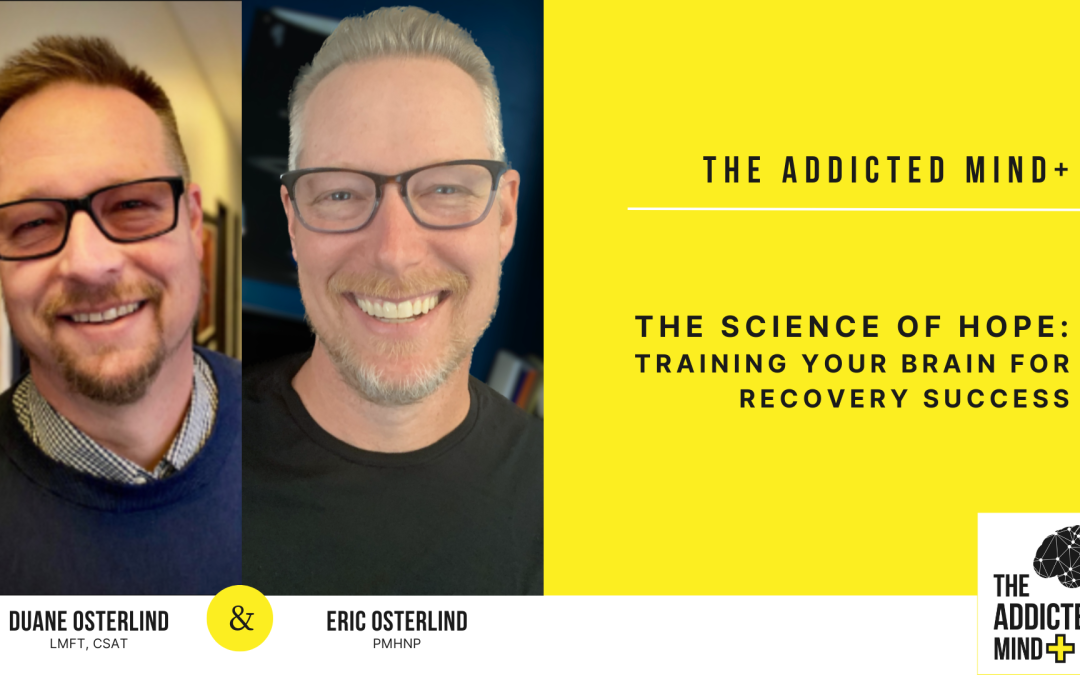Worksheet: Hope Building Blueprint
What do you do when your hope tank is completely empty? When you’re going through the motions of recovery but deep down don’t believe things will ever really get better?
In this powerful episode of The Addicted Mind Plus, hosts Duane Osterlind and Eric Osterlind tackle one of the most critical—and often overlooked—elements of lasting recovery: hope. But this isn’t a conversation about wishful thinking or waiting for motivation to magically strike. Instead, they dive into the practical science of hope and show you exactly how to cultivate it, even when you’re starting from bare ground.
Many people in recovery struggle with a toxic sense of hopelessness—that gray, heavy belief that the future will just repeat the past. It’s the voice that whispers, “Lasting recovery is for other people, not me. I’m too broken. I’ve failed too many times.” This feeling drains motivation and makes recovery feel like an exhausting chore rather than an opportunity for a better life.
Here’s the good news: positive psychology research shows that hope isn’t just a feeling you have to wait for. It’s actually a trainable cognitive skill you can build, just like going to the gym and strengthening a muscle.
Duane and Eric break down Dr. C.R. Snyder’s groundbreaking Hope Theory, which identifies two essential components of hope: pathway thinking (the belief that you can find routes to your goals—the “how to” part) and agency thinking (the belief in your own ability to use those paths—the “I can do this” part). When you feel hopeless, it’s usually because you’ve lost one or both of these elements.
The episode gets wonderfully practical with two concrete action steps you can start using today:
Action Step #1: Set One Hopeful, Achievable Goal – Choose one small, realistic, and measurable goal you can work on this month (or even just today). Not something vague like “be happier” or “fix my life,” but something specific like “spend 10 minutes outside three times this week” or “make one phone call to a supportive friend.” Writing it down literally creates a pathway forward in your brain.
Action Step #2: Visualize Your Success – Take 2-3 minutes to close your eyes and vividly imagine yourself achieving that goal. Don’t just see it—feel it. Imagine the pride, relief, and satisfaction of crossing it off your list. This isn’t just positive thinking fluff—it’s neuroscience. Elite Olympic athletes use this exact technique to improve their performance, and research shows visualization can be as beneficial as additional physical training.
The hosts explain that this process directly builds self-efficacy—your belief in your ability to succeed. Hope isn’t just believing things can get better; it’s taking small steps that create evidence they ARE getting better.
Throughout the episode, Duane and Eric’s compassionate approach shines through. They acknowledge that both pathway thinking and agency thinking can be incredibly difficult to access in recovery, but they offer genuine encouragement that these skills can be developed over time.
To support your journey, they’ve created a free Hope Building Blueprint worksheet—a simple one-page guide to help you define your hopeful goal, brainstorm the pathway to get there, and list your motivation and visualization strategies.
If you’re struggling with hopelessness in recovery, this episode offers both the science and the practical tools to start building hope today. You deserve to believe in a better future—and now you have a roadmap to get there.
Key Topics
- The Neuroscience of Negativity – Why our brains are wired to focus on negative emotions and predictions first
- Dr. C.R. Snyder’s Hope Theory – The two essential components: pathway thinking and agency thinking
- Pathway vs. Agency – Understanding which element of hope you’re struggling with most
- Small Goals Build Self-Efficacy – How tiny, achievable wins create evidence of progress and fuel motivation
- The Power of Visualization – Using Olympic athlete techniques to prime your brain for success
- Actionable Hope-Building Steps – Two concrete practices to start cultivating hope today
- Free Hope Building Blueprint – Downloadable worksheet to guide your goal-setting and visualization practice
Timestamp List
00:00 – Introduction: What is the most powerful fuel for recovery?
02:00 – The pain point of hopelessness and why it’s toxic to recovery
04:00 – Why our brains are wired for negativity and how positive psychology offers a new lens
06:00 – Breaking down the two essential parts of hope: pathway thinking and agency thinking
09:00 – Action Step #1: Setting one hopeful, achievable goal that’s specific and measurable
11:00 – Action Step #2: Visualizing your success using neuroscience-backed techniques
14:00 – Recap and introduction to the free Hope Building Blueprint worksheet
Follow and Review: We’d love it even more if you could drop a review or 5-star rating over on Apple Podcasts. Simply select “Ratings and Reviews” and “Write a Review” then a quick line with your favorite part of the episode. It only takes a second and it helps spread the word about the podcast.
Supporting Resources:
If you live in California and are looking for counseling or therapy please check out Novus Mindful Life Counseling and Recovery Center
We want to hear from you. Leave us a message or ask us a question: https://www.speakpipe.com/addictedmind

